Lincoln Electric IM609-B User Manual
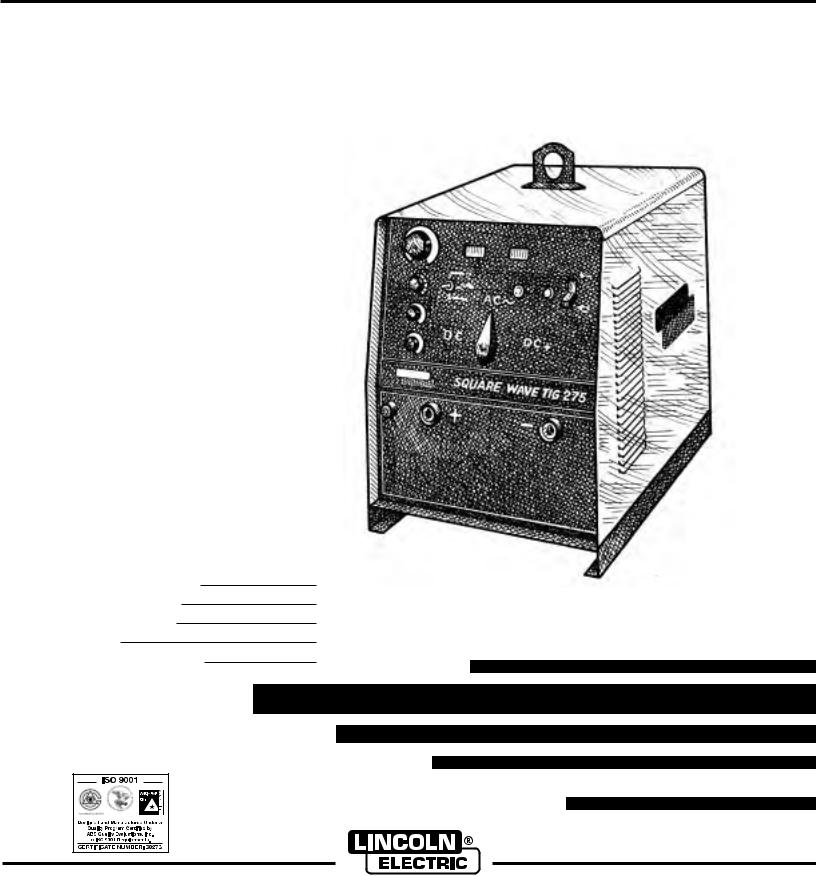
RETURN TO MAIN MENU
IM609-B
Square Wave TIG 275 |
May, 2001 |
|
For use with machines having Code Numbers: 10523,
10524,
10525,
10605,
10738
Safety Depends on You
Lincoln arc welding and cutting equipment is designed and built with safety in mind. However, your overall safety can be increased by proper installation ... and thoughtful operation on your part. DO NOT
INSTALL, OPERATE OR REPAIR THIS EQUIPMENT WITHOUT READING THIS MANUAL AND THE SAFETY PRECAUTIONS CONTAINED THROUGHOUT. And, most importantly, think before you act and be careful.
Date of Purchase:
Serial Number:
Code Number:
Model:
Where Purchased:
OPERATOR’S MANUAL
Copyright © 2001 Lincoln Global Inc.
•World's Leader in Welding and Cutting Products •
•Sales and Service through Subsidiaries and Distributors Worldwide •
Cleveland, Ohio 44117-1199 U.S.A. TEL: 216.481.8100 FAX: 216.486.1751 WEB SITE: www.lincolnelectric.com
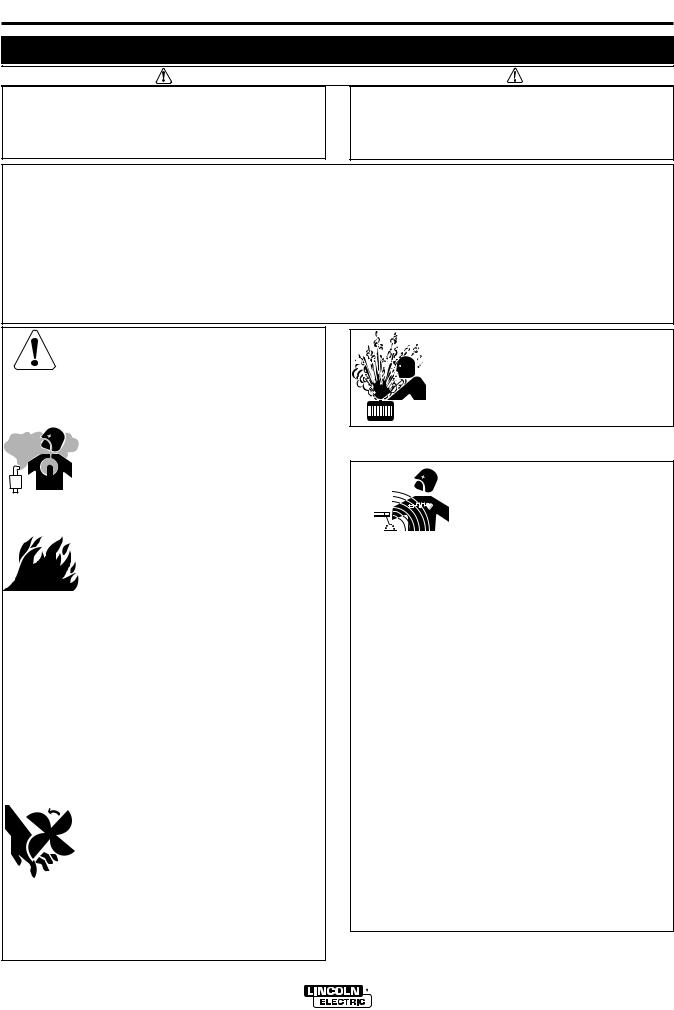
i
SAFETY
i
 WARNING
WARNING
CALIFORNIA PROPOSITION 65 WARNINGS
For Diesel Engines: Diesel engine exhaust and some of its constituents are known to the State of California to cause cancer, birth defects, and other reproductive harm.
For Gasoline Engines: The engine exhaust from this product contains chemicals known to the State of California to cause cancer, birth defects, or other reproductive harm.
ARC WELDING CAN BE HAZARDOUS. PROTECT YOURSELF AND OTHERS FROM POSSIBLE SERIOUS INJURY OR DEATH. KEEP CHILDREN AWAY. PACEMAKER WEARERS SHOULD CONSULT WITH THEIR DOCTOR BEFORE OPERATING.
Read and understand the following safety highlights. For additional safety information, it is strongly recommended that you purchase a copy of “Safety in Welding & Cutting - ANSI Standard Z49.1” from the American Welding Society, P.O. Box 351040, Miami, Florida 33135 or CSA Standard W117.2-1974. A Free copy of “Arc Welding Safety” booklet E205 is available from the Lincoln Electric Company, 22801 St. Clair Avenue, Cleveland, Ohio 44117-1199.
BE SURE THAT ALL INSTALLATION, OPERATION, MAINTENANCE AND REPAIR PROCEDURES ARE PERFORMED ONLY BY QUALIFIED INDIVIDUALS.
FOR ENGINE powered equipment.
1.a. Turn the engine off before troubleshooting and maintenance work unless the maintenance work requires it to be running.
____________________________________________________
1.b. Operate engines in open, well-ventilated areas or vent the engine exhaust fumes
outdoors.
____________________________________________________
1.c. Do not add the fuel near an open flame welding arc or when the engine is running. Stop
the engine and allow it to cool before refueling to prevent spilled fuel from vaporizing on contact with hot engine parts and igniting. Do not spill fuel when filling tank. If fuel is spilled, wipe it up and do not start engine until fumes have been eliminated.
____________________________________________________
1.d. Keep all equipment safety guards, covers and devices in position and in good repair.Keep hands, hair, clothing and tools away from V-belts, gears, fans and all other moving parts when starting, operating or repairing equipment.
____________________________________________________
1.e. In some cases it may be necessary to remove safety guards to perform required maintenance. Remove guards only when necessary and replace them when the maintenance requiring their removal is complete.
Always use the greatest care when working near moving parts.
___________________________________________________
1.f. Do not put your hands near the engine fan. Do not attempt to override the governor or idler by pushing on the throttle control rods while the engine is running.
___________________________________________________
1.g. To prevent accidentally starting gasoline engines while turning the engine or welding generator during maintenance work, disconnect the spark plug wires, distributor cap or magneto wire as appropriate.
1.h. To avoid scalding, do not remove the radiator pressure cap when the engine is hot.
ELECTRIC AND MAGNETIC FIELDS may be dangerous
2.a. Electric current flowing through any conductor causes localized Electric and Magnetic Fields (EMF). Welding current creates EMF fields around welding cables and welding machines
2.b. EMF fields may interfere with some pacemakers, and welders having a pacemaker should consult their physician before welding.
2.c. Exposure to EMF fields in welding may have other health effects which are now not known.
2.d. All welders should use the following procedures in order to minimize exposure to EMF fields from the welding circuit:
2.d.1. Route the electrode and work cables together - Secure them with tape when possible.
2.d.2. Never coil the electrode lead around your body.
2.d.3. Do not place your body between the electrode and work cables. If the electrode cable is on your right side, the work cable should also be on your right side.
2.d.4. Connect the work cable to the workpiece as close as possible to the area being welded.
2.d.5. Do not work next to welding power source.
Mar ‘95
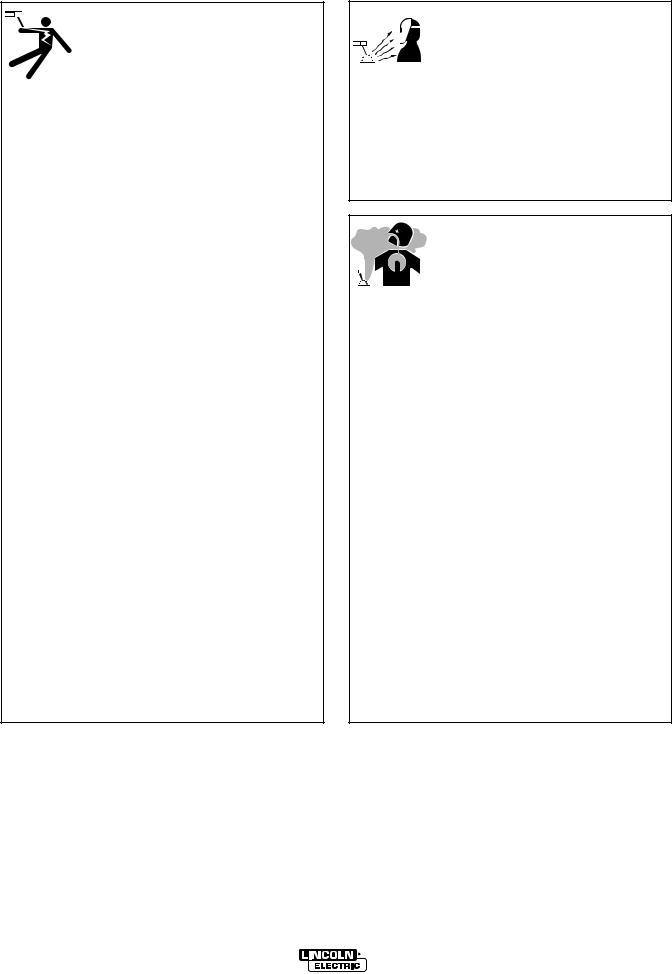
ii |
SAFETY |
ii |
|
|
|
|
|
|
ELECTRIC SHOCK can kill.
3.a. The electrode and work (or ground) circuits are electrically “hot” when the welder is on. Do not touch these “hot” parts with your bare skin or wet clothing. Wear dry, hole-free gloves to insulate hands.
3.b. Insulate yourself from work and ground using dry insulation. Make certain the insulation is large enough to cover your full area of physical contact with work and ground.
In addition to the normal safety precautions, if welding must be performed under electrically hazardous conditions (in damp locations or while wearing wet clothing; on metal structures such as floors, gratings or scaffolds; when in cramped positions such as sitting, kneeling or lying, if there is a high risk of unavoidable or accidental contact with the workpiece or ground) use the following equipment:
•Semiautomatic DC Constant Voltage (Wire) Welder.
•DC Manual (Stick) Welder.
•AC Welder with Reduced Voltage Control.
3.c. In semiautomatic or automatic wire welding, the electrode, electrode reel, welding head, nozzle or semiautomatic welding gun are also electrically “hot”.
3.d. Always be sure the work cable makes a good electrical connection with the metal being welded. The connection should be as close as possible to the area being welded.
3.e. Ground the work or metal to be welded to a good electrical (earth) ground.
3.f. Maintain the electrode holder, work clamp, welding cable and welding machine in good, safe operating condition. Replace damaged insulation.
3.g. Never dip the electrode in water for cooling.
3.h. Never simultaneously touch electrically “hot” parts of electrode holders connected to two welders because voltage between the two can be the total of the open circuit voltage of both welders.
3.i. When working above floor level, use a safety belt to protect yourself from a fall should you get a shock.
3.j. Also see Items 6.c. and 8.
ARC RAYS can burn.
4.a. Use a shield with the proper filter and cover plates to protect your eyes from sparks and the rays of the arc when welding or observing open arc welding. Headshield and filter lens should conform to ANSI Z87. I standards.
4.b. Use suitable clothing made from durable flame-resistant material to protect your skin and that of your helpers from the arc rays.
4.c. Protect other nearby personnel with suitable, non-flammable screening and/or warn them not to watch the arc nor expose themselves to the arc rays or to hot spatter or metal.
FUMES AND GASES can be dangerous.
5.a. Welding may produce fumes and gases hazardous to health. Avoid breathing these fumes and gases.When welding, keep your head out of the fume. Use enough ventilation and/or exhaust at the arc to keep
fumes and gases away from the breathing zone. When welding with electrodes which require special ventilation such as stainless or hard facing (see instructions on container or MSDS) or on lead or cadmium plated steel and other metals or coatings which produce highly toxic fumes, keep exposure as low as possible and below Threshold Limit Values (TLV) using local exhaust or mechanical ventilation. In confined spaces or in some circumstances, outdoors, a respirator may be required. Additional precautions are also required when welding on galvanized steel.
5.b. Do not weld in locations near chlorinated hydrocarbon vapors coming from degreasing, cleaning or spraying operations. The heat and rays of the arc can react with solvent vapors to form phosgene, a highly toxic gas, and other irritating products.
5.c. Shielding gases used for arc welding can displace air and cause injury or death. Always use enough ventilation, especially in confined areas, to insure breathing air is safe.
5.d. Read and understand the manufacturer’s instructions for this equipment and the consumables to be used, including the material safety data sheet (MSDS) and follow your employer’s safety practices. MSDS forms are available from your welding distributor or from the manufacturer.
5.e. Also see item 1.b.
Mar ‘95
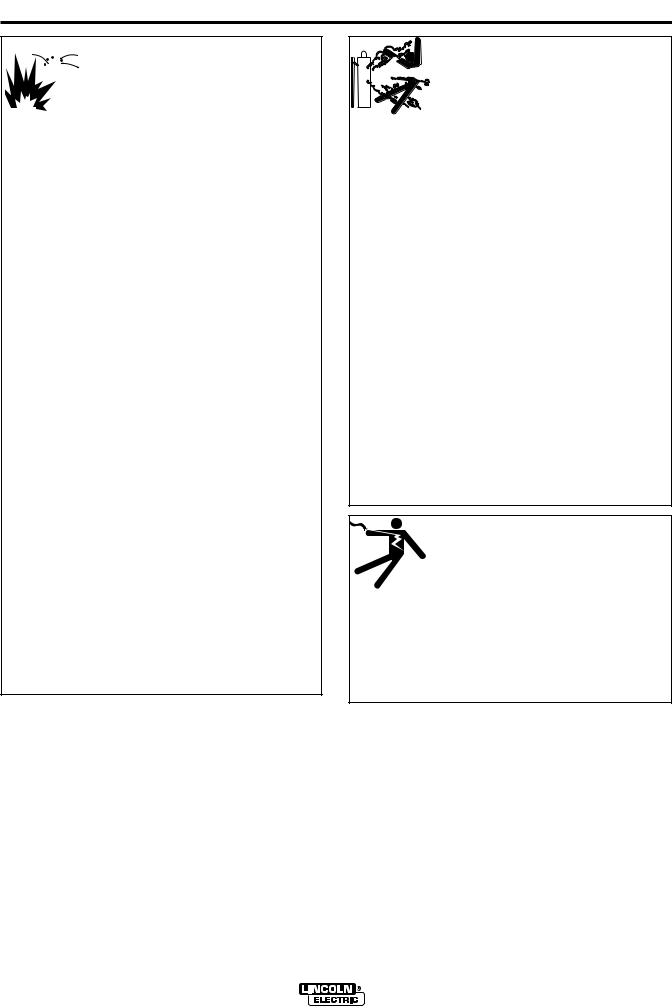
iii
SAFETY
iii

 WELDING SPARKS can
WELDING SPARKS can

 cause fire or explosion.
cause fire or explosion.
6.a. Remove fire hazards from the welding area. If this is not possible, cover them to prevent the welding sparks from starting a fire. Remember that welding sparks and hot
materials from welding can easily go through small cracks and openings to adjacent areas. Avoid welding near hydraulic lines. Have a fire extinguisher readily available.
6.b. Where compressed gases are to be used at the job site, special precautions should be used to prevent hazardous situations. Refer to “Safety in Welding and Cutting” (ANSI Standard Z49.1) and the operating information for the equipment being used.
6.c. When not welding, make certain no part of the electrode circuit is touching the work or ground. Accidental contact can cause overheating and create a fire hazard.
6.d. Do not heat, cut or weld tanks, drums or containers until the proper steps have been taken to insure that such procedures will not cause flammable or toxic vapors from substances inside. They can cause an explosion even though they have been “cleaned”. For information, purchase “Recommended
Safe Practices for the Preparation for Welding and Cutting of Containers and Piping That Have Held Hazardous Substances”, AWS F4.1 from the American Welding Society (see address above).
6.e. Vent hollow castings or containers before heating, cutting or welding. They may explode.
6.f. Sparks and spatter are thrown from the welding arc. Wear oil free protective garments such as leather gloves, heavy shirt, cuffless trousers, high shoes and a cap over your hair. Wear ear plugs when welding out of position or in confined places.
Always wear safety glasses with side shields when in a welding area.
6.g. Connect the work cable to the work as close to the welding area as practical. Work cables connected to the building framework or other locations away from the welding area increase the possibility of the welding current passing through lifting chains, crane cables or other alternate circuits.
This can create fire hazards or overheat lifting chains or cables until they fail.
6.h. Also see item 1.c.
CYLINDER may explode






 if damaged.
if damaged.
7.a. Use only compressed gas cylinders
containing the correct shielding gas for the process used and properly operating regulators designed for the gas and
pressure used. All hoses, fittings, etc. should be suitable for the application and maintained in good condition.
7.b. Always keep cylinders in an upright position securely chained to an undercarriage or fixed support.
7.c. Cylinders should be located:
•Away from areas where they may be struck or subjected to physical damage.
•A safe distance from arc welding or cutting operations and any other source of heat, sparks, or flame.
7.d. Never allow the electrode, electrode holder or any other electrically “hot” parts to touch a cylinder.
7.e. Keep your head and face away from the cylinder valve outlet when opening the cylinder valve.
7.f. Valve protection caps should always be in place and hand tight except when the cylinder is in use or connected for use.
7.g. Read and follow the instructions on compressed gas cylinders, associated equipment, and CGA publication P-l, “Precautions for Safe Handling of Compressed Gases in
Cylinders,” available from the Compressed Gas Association 1235 Jefferson Davis Highway, Arlington, VA 22202.
FOR ELECTRICALLY powered equipment.
8.a. Turn off input power using the disconnect switch at the fuse box before working on the equipment.
8.b. Install equipment in accordance with the U.S. National Electrical Code, all local codes and the manufacturer’s recommendations.
8.c. Ground the equipment in accordance with the U.S. National
Electrical Code and the manufacturer’s recommendations.
Mar ‘95
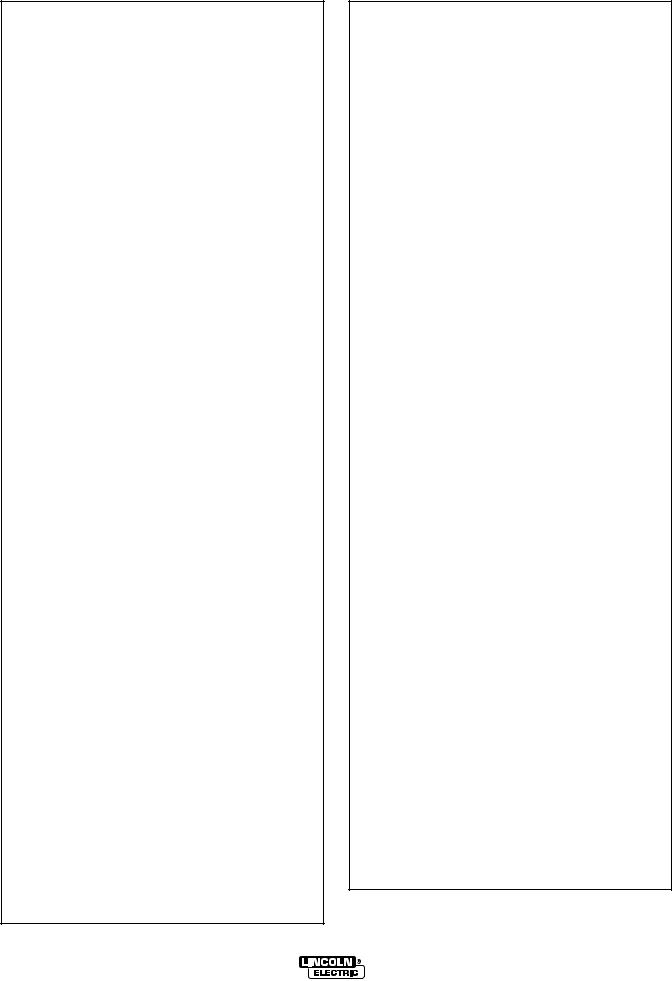
iv |
SAFETY |
iv |
|
|
|
PRÉCAUTIONS DE SÛRETÉ
Pour votre propre protection lire et observer toutes les instructions et les précautions de sûreté specifiques qui parraissent dans ce manuel aussi bien que les précautions de sûreté générales suivantes:
Sûreté Pour Soudage A L’Arc
1.Protegez-vous contre la secousse électrique:
a.Les circuits à l’électrode et à la piéce sont sous tension quand la machine à souder est en marche. Eviter toujours tout contact entre les parties sous tension et la peau nue ou les vétements mouillés. Porter des gants secs et sans trous pour isoler les mains.
b.Faire trés attention de bien s’isoler de la masse quand on soude dans des endroits humides, ou sur un plancher metallique ou des grilles metalliques, principalement dans les positions assis ou couché pour lesquelles une grande partie du corps peut être en contact avec la masse.
c.Maintenir le porte-électrode, la pince de masse, le câble de soudage et la machine à souder en bon et sûr état defonctionnement.
d.Ne jamais plonger le porte-électrode dans l’eau pour le refroidir.
e.Ne jamais toucher simultanément les parties sous tension des porte-électrodes connectés à deux machines à souder parce que la tension entre les deux pinces peut être le total de la tension à vide des deux machines.
f.Si on utilise la machine à souder comme une source de courant pour soudage semi-automatique, ces precautions pour le porte-électrode s’applicuent aussi au pistolet de soudage.
2.Dans le cas de travail au dessus du niveau du sol, se protéger contre les chutes dans le cas ou on recoit un choc. Ne jamais enrouler le câble-électrode autour de n’importe quelle partie du corps.
3.Un coup d’arc peut être plus sévère qu’un coup de soliel, donc:
a.Utiliser un bon masque avec un verre filtrant approprié
ainsi qu’un verre blanc afin de se protéger les yeux du rayonnement de l’arc et des projections quand on soude ou quand on regarde l’arc.
b.Porter des vêtements convenables afin de protéger la peau de soudeur et des aides contre le rayonnement de l‘arc.
c.Protéger l’autre personnel travaillant à proximité au soudage à l’aide d’écrans appropriés et non-inflammables.
4.Des gouttes de laitier en fusion sont émises de l’arc de soudage. Se protéger avec des vêtements de protection libres de l’huile, tels que les gants en cuir, chemise épaisse, pantalons sans revers, et chaussures montantes.
5.Toujours porter des lunettes de sécurité dans la zone de soudage. Utiliser des lunettes avec écrans lateraux dans les zones où l’on pique le laitier.
6.Eloigner les matériaux inflammables ou les recouvrir afin de prévenir tout risque d’incendie dû aux étincelles.
7.Quand on ne soude pas, poser la pince à une endroit isolé de la masse. Un court-circuit accidental peut provoquer un échauffement et un risque d’incendie.
8.S’assurer que la masse est connectée le plus prés possible de la zone de travail qu’il est pratique de le faire. Si on place la masse sur la charpente de la construction ou d’autres endroits éloignés de la zone de travail, on augmente le risque de voir passer le courant de soudage par les chaines de levage, câbles de grue, ou autres circuits. Cela peut provoquer des risques d’incendie ou d’echauffement des chaines et des câbles jusqu’à ce qu’ils se rompent.
9.Assurer une ventilation suffisante dans la zone de soudage.
Ceci est particuliérement important pour le soudage de tôles galvanisées plombées, ou cadmiées ou tout autre métal qui produit des fumeés toxiques.
10.Ne pas souder en présence de vapeurs de chlore provenant d’opérations de dégraissage, nettoyage ou pistolage. La chaleur ou les rayons de l’arc peuvent réagir avec les vapeurs du solvant pour produire du phosgéne (gas fortement toxique) ou autres produits irritants.
11.Pour obtenir de plus amples renseignements sur la sûreté, voir le code “Code for safety in welding and cutting” CSA Standard W 117.2-1974.
PRÉCAUTIONS DE SÛRETÉ POUR LES MACHINES À SOUDER À TRANSFORMATEUR ET À REDRESSEUR
1.Relier à la terre le chassis du poste conformement au code de l’électricité et aux recommendations du fabricant. Le dispositif de montage ou la piece à souder doit être branché à une bonne mise à la terre.
2.Autant que possible, I’installation et l’entretien du poste seront effectués par un électricien qualifié.
3.Avant de faires des travaux à l’interieur de poste, la debrancher à l’interrupteur à la boite de fusibles.
4.Garder tous les couvercles et dispositifs de sûreté à leur place.
Mar. ‘93
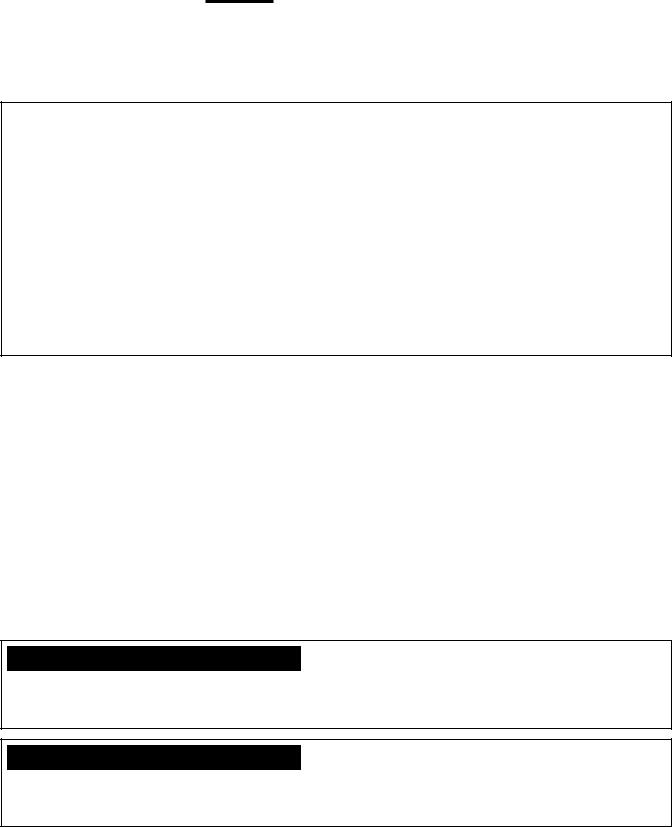
v
Thank You
v
for selecting a QUALITY product by Lincoln Electric. We want you to take pride in operating this Lincoln Electric Company product •••
as much pride as we have in bringing this product to you!
Please Examine Carton and Equipment For Damage Immediately
When this equipment is shipped, title passes to the purchaser upon receipt by the carrier. Consequently, Claims for material damaged in shipment must be made by the purchaser against the transportation company at the time the shipment is received.
Please record your equipment identification information below for future reference. This information can be found on your machine nameplate.
Model Name & Number _____________________________________
Code & Serial Number _____________________________________
Date of Purchase _____________________________________
Whenever you request replacement parts for or information on this equipment always supply the information you have recorded above.
Read this Operators Manual completely before attempting to use this equipment. Save this manual and keep it handy for quick reference. Pay particular attention to the safety instructions we have provided for your protection. The level of seriousness to be applied to each is explained below:
 WARNING
WARNING
This statement appears where the information must be followed exactly to avoid serious personal injury or loss of life.
 CAUTION
CAUTION
This statement appears where the information must be followed to avoid minor personal injury or damage to this equipment.

vi |
TABLE OF CONTENTS |
|
|
|
vi |
||||
|
|
|
|
|
|
Page |
|||
|
|
|
|
|
|
|
|||
|
|
Installation ....................................................................................................... |
Section A |
||||||
|
|
Technical Specifications................................................................................. |
A - 1, A-2 |
||||||
|
|
Select Suitable Location ........................................................................................ |
A-3 |
||||||
|
|
Stacking ................................................................................................................. |
A-3 |
||||||
|
|
Lifting and Moving ................................................................................................. |
A-3 |
||||||
|
|
Tilting. .................................................................................................................... |
A-3 |
||||||
|
|
Environmental Rating ........................................................................................... |
A-3 |
||||||
|
|
Machine Grounding and High Frequency Interference Protection |
........................A-3 |
||||||
|
|
Supply Connections............................................................................................... |
A-4 |
||||||
|
|
Input Reconnect Procedures................................................................................. |
A-5 |
||||||
|
|
Output Connections............................................................................................... |
A-7 |
||||||
|
|
Work Cable Connections....................................................................................... |
A-7 |
||||||
|
|
TIG Torch Connections .......................................................................................... |
A-8 |
||||||
|
|
Twist-Mate Adapter for LA-9 and LA-17 TIG Torch................................................ |
A-9 |
||||||
|
|
Twist-Mate Adapter for LW-18 and LW-20 TIG Torch ............................................ |
A-9 |
||||||
|
|
Stick Electrode Cable Connection ....................................................................... |
A-10 |
||||||
|
|
Installation of Field Installed Options................................................................... |
A-10 |
||||||
|
|
|
|
|
|
|
|||
|
|
Operation ......................................................................................................... |
Section B |
||||||
|
|
Safety Precautions ............................................................................................... |
B-1 |
||||||
|
|
Graphic Symbol Definitions ................................................................................... |
B-2 |
||||||
|
|
General Description............................................................................................... |
B-4 |
||||||
|
|
Recommended Processes and Equipment ........................................................... |
B-4 |
||||||
|
|
Design Features and Advantages ......................................................................... |
B-4 |
||||||
|
|
Limitations.............................................................................................................. |
B-5 |
||||||
|
|
Duty Cycle and Time Period.................................................................................. |
B-5 |
||||||
|
|
Controls and Settings ............................................................................................ |
B-6 |
||||||
|
|
Welding Operation ................................................................................................. |
B-7 |
||||||
|
|
Auxiliary Power .................................................................................................... |
B-10 |
||||||
|
|
|
|
|
|
|
|||
|
|
Accessories..................................................................................................... |
Section C |
||||||
|
|
Accessories Included with Machine ...................................................................... |
C-1 |
||||||
|
|
Optional Accessories............................................................................................. |
C-1 |
||||||
|
|
|
|
|
|
|
|||
|
|
Maintenance .................................................................................................... |
Section D |
||||||
|
|
Safety Precautions ................................................................................................ |
D-1 |
||||||
|
|
Routine and Periodic Maintenance ....................................................................... |
D-1 |
||||||
|
|
Overload Protection............................................................................................... |
D-1 |
||||||
|
|
Service Procedures............................................................................................... |
D-1 |
||||||
|
|
Component Location and Access ......................................................................... |
D-2 |
||||||
|
|
Spark Gap Adjustment .......................................................................................... |
D-2 |
||||||
|
|
|
|
|
|
|
|||
|
|
Troubleshooting .............................................................................................. |
Section E |
||||||
|
|
Safety Precautions................................................................................................. |
E-1 |
||||||
|
|
How To Use Troubleshooting Guide ...................................................................... |
E-1 |
||||||
|
|
Troubleshooting Guide........................................................................................... |
E-2 |
||||||
|
|
PC Board Troubleshooting..................................................................................... |
E-7 |
||||||
|
|
|
|
|
|
|
|||
|
|
Wiring Diagrams & Dimension Print ............................................................. |
Section F |
||||||
|
|
|
|
|
|
||||
|
|
Parts List ...................................................................................................... |
P316 Series |
||||||
|
|
|
|
|
|||||
|
|
Parts List ...................................................................................................... |
P383 Series |
||||||
|
|
|
|
|
|
|
|
|
|
|
|
|
|
|
|
|
|
|
|
|
|
|
|
|
|
|
|
|
|
|
|
|
|
|
|
|
|
|
|
|
|
|
|
|
|
|
|
|
|
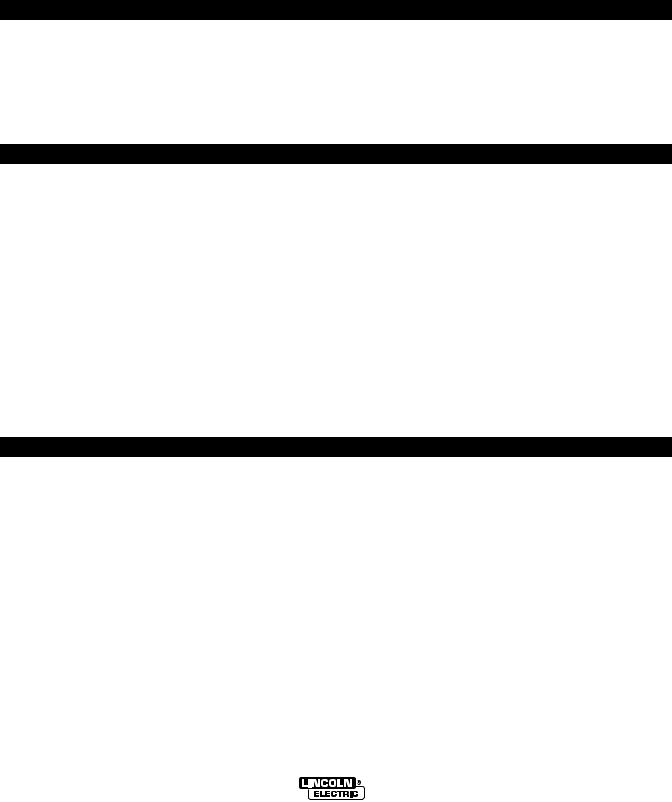
A-1 |
|
|
|
|
|
INSTALLATION |
|
|
|
|
|
|
A-1 |
|||||
|
|
|
|
|
|
|
|
|
|
|
|
|
|
|
|
|
|
|
TECHNICAL SPECIFICATIONS - Square Wave TIG 275 (K1617-1, and -2) |
|
|
||||||||||||||||
|
|
|
|
|
|
|
|
|
|
|
|
|
|
|
|
|
|
|
|
|
|
|
|
|
INPUT - SINGLE PHASE ONLY |
|
|
|
|
|
|
|
|||||
|
|
|
|
|
|
|
|
|
|
|
|
|
|
|
|
|
|
|
|
|
Standard |
Input Current at |
|
Input Current at |
Input Current at |
|
Idle |
Idle Power |
|
|
Code |
|
|||||
|
|
Voltage |
40% |
Duty Cycle |
|
60% Duty Cycle |
100% Duty Cycle |
|
Current |
Power |
|
|
Number |
|
||||
|
|
|
|
DC STICK, |
|
|
|
DC STICK, |
|
DC STICK, |
|
|
|
|
|
|
|
|
|
|
|
|
DC TIG, |
|
UNBALANCED AC TIG |
DC TIG, |
UNBALANCED AC TIG |
DC TIG, |
UNBALANCED AC TIG |
|
|
|
|
|
|
|
|
|
|
|
|
BALANCED AC TIG |
|
|
BALANCED AC TIG |
|
BALANCED AC TIG |
|
|
|
|
|
|
|
|
|
|
208/230/460/1/60 (K1617-1) |
|
|
|
|
|
|
|
|
|
|
|
|
|
|
|
||
|
95/86/43 |
|
130/120/61 |
|
76/69/34 |
106/97/50 |
57/52/26 |
82/75/38 |
5/4/2 |
900 WMax. |
|
|
|
|
||||
|
460/575/1/60 (K1617-2) |
|
|
|
|
10523 |
|
|||||||||||
|
208/230/460/1/60 (K1617-1) |
43/35 |
|
61/49 |
|
34/28 |
50/41 |
26/21 |
38/31 |
2/1.5 |
900 WMax. |
|
|
10525 |
|
|||
|
|
|
|
95/86/43 |
|
130/120/61 |
|
76/69/34 |
106/97/50 |
57/52/26 |
82/75/38 |
5/4/2 |
900 WMax. |
|
|
10605 |
|
|
|
|
|
|
|
|
|
|
|
|
|
|
|
|
|
|
|
|
|
RATED OUTPUT & ADDITIONAL OUTPUT CAPACITY
|
Duty Cycle |
|
Amps |
Volts at Rated Amperes |
Current Range |
Auxiliary Power |
|
|
40% Duty Cycle |
AC/DC Stick |
275 A |
31.0 V |
5-315 Amps |
115 Volts AC, 10 Amps |
|
|
NEMA Class II (40) |
AC/DC TIG |
255 A |
16.1 V |
|
Grounded NEMA-5-15R |
|
|
|
|
|
|
MAX O.C.V. |
Receptacle and |
|
|
|
|
|
|
|
||
|
60% Duty Cycle |
AC/DC Stick |
225 A |
29.0 V |
10 Amp Circuit Breaker |
|
|
|
|
AC/DC TIG |
200 A |
15.4 V |
AC & DC 80V |
|
|
|
|
|
|
|
|
|
|
|
|
|
|
|
Normal O.C.V. |
|
|
|
100% Duty Cycle |
AC/DC Stick |
175 A |
27.0 V |
|
|
|
|
|
AC/DC TIG |
150 A |
14.8 V |
72 V (AC) 59 V (DC) |
|
|
|
|
|
|
|
|
|
|
|
|
|
|
|
|
|
|
RECOMMENDED INPUT WIRE AND FUSE SIZES
|
|
|
|
|
|
|
|
|
|
|
|
|
|
|
|
|
|
|
|
|
|
|
|
|
|
|
|
|
For AC/DC Stick, DC TIG and Balanced AC TIG |
|
|
For Unbalanced AC TIG Welding above 180A, |
|
|
|||||||||||||
|
|
|
|
|
Welding at 275A 40% Duty Cycle |
|
|
255A 40% Duty Cycle, Maximum Penetration |
|
|
|||||||||||||
|
|
|
|
|
w/o Optional K1620-1 Power Factor Capacitors |
|
|
w/o Optional K1620-1 Power Factor Capacitors |
|
|
|||||||||||||
|
|
|
|
|
Based on the 1996 U.S. National Electrical Code |
|
|
Based on the 1996 U.S. National Electrical Code |
|
|
|||||||||||||
|
|
|
|
|
|
|
|
|
|
|
|
|
|
|
|
|
|
|
|
|
|
|
|
|
|
|
|
|
|
|
|
|
|
Type 75°C |
|
Type 75°C |
|
|
|
|
Type 75°C |
|
|
Type 75°C |
|
||
|
Input |
|
|
|
Fuse |
|
Input |
|
|
Copper Wire in |
|
Copper Ground |
|
Fuse |
Input |
|
Copper Wire in |
|
|
Copper Ground |
|
||
|
Voltage / |
|
|
(Super Lag) |
|
Amperes |
|
|
Conduit AWG |
|
Wire in |
(Super Lag) |
Amperes |
|
Conduit AWG |
|
|
Wire in |
|
||||
|
phase/ |
|
|
or Breaker |
|
|
|
|
(IEC) Sizes |
|
Conduit AWG |
or Breaker |
|
|
(IEC) Sizes |
|
|
Conduit AWG |
|
||||
|
Frequency |
|
|
|
Size(1) |
|
|
|
|
40°C (104°F) Ambient |
|
(IEC) Sizes |
|
Size(1) |
|
|
40°C (104°F) Ambient |
|
|
(IEC) Sizes |
|
||
|
|
|
|
|
|
|
|
|
|
|
|
|
|
|
|
|
|
|
|
||||
|
208/1/60 |
|
|
125 |
|
111 |
|
|
4 (21.2 mm2) |
|
6 (13.3 mm2) |
150 |
130 |
|
3 (25.0 mm2) |
|
|
6 (13.3 mm2) |
|
||||
|
230/1/60 |
|
|
125 |
|
100 |
|
|
4 (21.2 mm2) |
|
6 (13.3 mm2) |
150 |
120 |
|
3 (25.0 mm2) |
|
|
6 (13.3 mm2) |
|
||||
|
460/1/60 |
|
|
60 |
|
50 |
|
|
8 (8.4 mm2) |
|
10 (5.3 mm2) |
70 |
61 |
|
8 (8.4 mm2) |
|
|
8 (8.4 mm2) |
|
||||
|
575/1/60 |
|
|
50 |
|
40 |
|
|
10 (5.3 mm2) |
|
10 (5.3 mm2) |
60 |
49 |
|
8 (8.4 mm2) |
|
|
10 (5.3 mm2) |
|
||||
(1)Also called “inverse time” or “thermal/magnetic” circuit breakers; circuit breakers which have a delay in tripping action that decreases as the magnitude of current increases.
PHYSICAL DIMENSIONS
|
Height |
Width |
Depth |
Weight |
Power |
24.06 in. |
19.15 in. |
28.00 in. |
Approx. 330 lbs. |
Source |
611 mm |
486 mm |
711 mm |
150 kg. |
|
Lift Hook add 3.57” (91 mm) |
|
|
|
|
|
|
|
|
Power Source |
33.40 in. |
27.65 in. |
40.65 in. |
Approx. 375 lbs. |
on |
848 mm |
702 mm |
1033 mm |
170 kg. |
Undercarriage |
|
|
|
|
|
|
|
|
|
SQUARE WAVE TIG 275

A-2 |
|
|
|
|
|
|
|
|
|
|
|
|
|
|
|
INSTALLATION |
|
|
|
|
|
|
|
|
|
|
A-2 |
||||||||||||||||
|
|
|
|
|
|
|
|
|
|
|
|
|
|
|
|
|
|
|
|
|
|
|
|
|
|
|
|
|
|
|
|
|
|
|
|
|
|
|
|
|
|
|
|
TECHNICAL SPECIFICATIONS - Square Wave TIG 275 (K1618-1) |
|
|
|
|
|
|
|
|
|
||||||||||||||||||||||||||||||||||
|
|
|
|
|
|
|
|
|
|
|
|
|
|
|
|
|
|
|
|
|
|
|
|
|
|
|
|
|
|
|
|
|
|
|
|
|
|
|
|
||||
|
|
|
|
|
|
|
|
|
|
|
|
|
|
|
|
|
INPUT - SINGLE PHASE ONLY |
|
|
|
|
|
|
|
|
|
|
|
|||||||||||||||
|
|
Standard |
|
|
|
Input Current at |
|
Input Current at |
|
|
Input Current at |
|
Idle Current |
Idle Power |
Code |
|
|||||||||||||||||||||||||||
|
|
|
|
|
40% Duty Cycle |
|
60% Duty Cycle |
|
|
100% Duty Cycle |
|
|
|
|
|
|
Number |
|
|||||||||||||||||||||||||
|
|
|
Voltage |
|
|
|
|
|
|
|
|
|
|
|
|
|
|||||||||||||||||||||||||||
|
|
|
|
|
|
|
|
|
DC STICK, |
|
|
|
|
|
|
DC STICK, |
|
|
|
DC STICK, |
|
|
|
|
|
|
|
|
|
|
|
|
|||||||||||
|
|
220/380/415/1/50/60 |
|
DC TIG, |
UNBALANCED AC TIG |
DC TIG, |
|
UNBALANCED AC TIG |
DC TIG, |
|
|
UNBALANCED AC TIG |
|
|
|
|
|
|
|
|
|
|
|||||||||||||||||||||
|
|
BALANCED AC TIG |
|
|
|
|
|
|
BALANCED AC TIG |
|
|
|
|
|
BALANCED AC TIG |
|
|
|
|
|
|
|
|
|
|
|
|
|
|||||||||||||||
|
|
|
|
|
|
|
|
|
|
|
|
|
|
|
|
|
|
|
|
|
|
|
|
|
|
|
|
|
|
||||||||||||||
|
|
|
|
|
|
|
|
|
99/57/52 |
|
139/79/72 |
|
83/45/421 |
12/64/59 |
|
|
|
63/36/33 |
86/49/45 |
|
8/6/5 |
900 WMax. |
10524 |
|
|
|
|||||||||||||||||
|
|
|
|
|
|
|
|
|
|
|
|
|
|
|
|
|
|
|
|
|
|
|
|
|
|
|
|
|
|
||||||||||||||
|
|
|
|
|
|
|
|
|
|
|
RATED OUTPUT & ADDITIONAL OUTPUT CAPACITY |
|
|
|
|
|
|
|
|
|
|||||||||||||||||||||||
|
|
Duty Cycle |
|
|
|
|
|
|
|
|
|
|
|
|
|
Amps |
Volts at Rated Amperes |
|
Current Range |
|
Auxiliary Power |
|
|||||||||||||||||||||
|
|
40% Duty Cycle |
|
AC/DC Stick |
|
|
|
|
275 A |
|
31.0 V |
|
|
|
|
|
5-315 Amps |
|
220 Volts AC, 2 Amps |
|
|||||||||||||||||||||||
|
|
NEMA Class II (40) |
|
|
AC/DC TIG |
|
|
|
|
255 A |
|
20.2 V |
|
|
|
|
|
|
|
|
|
Schuko Receptacle |
|
||||||||||||||||||||
|
|
|
|
|
|
|
|
|
|
|
|
|
|
|
|
|
|
|
|
|
|
|
|
|
|
|
|
|
|
MAX O.C.V. |
|
and 2 Amp Circuit Breaker |
|
|
|||||||||
|
|
60% Duty Cycle |
|
|
AC/DC Stick |
|
|
|
|
225 A |
|
29.0 V |
|
|
|
|
|
|
|
|
|||||||||||||||||||||||
|
|
|
|
|
|
|
|
|
|
|
|
|
|
|
|
|
|
|
|
|
|
|
|
|
|||||||||||||||||||
|
|
|
|
|
|
|
|
|
|
|
AC/DC TIG |
|
|
|
|
200 A |
|
18.0 V |
|
|
|
|
AC & DC 80V |
|
|
|
|
|
|
|
|
|
|
|
|||||||||
|
|
|
|
|
|
|
|
|
|
|
|
|
|
|
|
|
|
|
|
|
|
|
|
|
|
|
|
|
|||||||||||||||
|
|
|
|
|
|
|
|
|
|
|
|
|
|
|
|
|
|
|
|
|
|
|
|
|
|
|
|
|
Normal O.C.V. |
|
|
|
|
|
|
|
|
|
|
|
|||
|
|
100% Duty Cycle |
|
|
AC/DC Stick |
|
|
|
|
175 A |
|
27.0 V |
|
|
|
|
|
|
|
|
|
|
|
|
|
|
|
||||||||||||||||
|
|
|
|
|
|
|
|
|
|
|
AC/DC TIG |
|
|
|
|
150 A |
|
16.0 V |
|
|
|
72 V (AC) 59 V (DC) |
|
|
|
|
|
|
|
|
|
|
|||||||||||
|
|
|
|
|
|
|
|
|
|
|
|
|
|
|
|
|
|
|
|
|
|
|
|
|
|
|
|
|
|
|
|
|
|
|
|
|
|||||||
|
|
|
|
|
|
|
|
|
|
|
|
|
|
|
|
|
|
|
|
|
|
|
|
|
|
|
|
|
|
|
|
|
|
|
|
|
|
|
|
|
|
|
|
|
|
|
|
|
|
|
|
|
|
|
RECOMMENDED INPUT WIRE AND FUSE SIZES |
|
|
|
|
|
|
|
|
|
|||||||||||||||||||||||
|
|
|
|
|
|
|
|
|
|
|
|
|
|
|
|
|
|
|
|
|
|
|
|
|
|
|
|
|
|
|
|
|
|
|
|
|
|||||||
|
|
|
|
|
|
|
|
|
|
|
|
|
|
|
|
|
|
|
|
|
|
|
|
|
|
|
|
|
|
|
|
|
|
|
|
|
|
|
|
|
|||
|
|
|
|
|
|
|
For AC/DC Stick, DC TIG and Balanced AC TIG |
||||||||||||||||||||||||||||||||||||
|
|
|
|
|
|
|
|
|
|
|
For Unbalanced AC TIG Welding above 180A, |
||||||||||||||||||||||||||||||||
|
|
|
|
|
|
|
|
|
Welding at 275A 40% Duty Cycle |
|
|
|
|
255A 40% Duty Cycle, Maximum Penetration |
|
|
|
|
|||||||||||||||||||||||||
|
|
|
|
|
|
|
w/o Optional K1620-1 Power Factor Capacitors |
|
|
|
|
w/o Optional K1620-1 Power Factor Capacitors |
|
|
|
|
|||||||||||||||||||||||||||
|
|
|
|
|
|
|
Based on the 1996 U.S. National Electrical Code |
|
|
|
Based on the 1996 U.S. National Electrical Code |
|
|
|
|
||||||||||||||||||||||||||||
|
|
|
|
|
|
|
|
|
|
|
|
|
|
|
|
|
|
|
|
|
|
|
|
|
|
|
|
|
|
|
|
|
|
|
|
|
|
|
|
|
|
|
|
|
|
|
|
|
|
|
|
|
|
|
|
|
|
|
Type 75°C |
|
|
Type 75°C |
|
|
|
|
|
|
|
|
|
|
Type 75°C |
|
|
|
Type 75°C |
|
|
|
|||||||
|
|
Input |
|
|
|
Fuse |
|
|
Input |
|
|
|
Copper Wire in |
|
Copper Ground |
|
|
|
Fuse |
|
|
Input |
|
Copper Wire in |
|
|
Copper Ground |
|
|
|
|||||||||||||
|
|
Voltage / |
|
|
(Super Lag) |
|
Amperes |
|
|
Conduit AWG |
|
|
Wire in |
|
(Super Lag) |
|
Amperes |
|
Conduit AWG |
|
|
|
Wire in |
|
|
|
|||||||||||||||||
|
|
phase/ |
|
|
or Breaker |
|
|
|
|
|
(IEC) Sizes |
|
|
Conduit AWG |
|
or Breaker |
|
|
|
|
(IEC) Sizes |
|
|
|
Conduit AWG |
|
|
|
|||||||||||||||
|
|
Frequency |
|
|
|
Size(1) |
|
|
|
|
|
|
40°C (104°F) Ambient |
|
|
(IEC) Sizes |
|
|
|
Size(1) |
|
|
|
|
40°C (104°F) Ambient |
|
|
(IEC) Sizes |
|
|
|
||||||||||||
|
|
|
|
|
|
|
|
|
|
|
|
|
|
|
|
|
|
|
|
|
|
|
|
|
|
|
|
|
|
|
|
|
|
|
|
|
|
||||||
|
220/1/50/60 |
|
|
125 |
|
|
|
106 |
|
|
|
4 (21.2 mm2) |
|
|
6 (13.3 mm2) |
|
175 |
|
|
139 |
|
3 (25.0 mm2) |
|
|
|
6 (13.3 mm2) |
|
|
|
||||||||||||||
|
380/1/50/60 |
|
|
70 |
|
|
|
60 |
|
|
|
8 (8.4 mm2) |
|
|
8 (8.4 mm2) |
|
90 |
|
|
79 |
|
6 (13.3 mm2) |
|
|
|
8 (8.4 mm2) |
|
|
|
||||||||||||||
|
415/1/50/60 |
|
|
70 |
|
|
|
55 |
|
|
|
8 (8.4 mm2) |
|
|
8 (8.4 mm2) |
|
90 |
|
|
72 |
|
6 (13.3 mm2) |
|
|
|
8 (8.4 mm2) |
|
|
|
||||||||||||||
|
|
|
|
|
|
|
|
|
|
|
|
|
|
|
|
|
|
|
|
|
|
|
|
|
|
|
|
|
|
|
|
|
|
|
|
|
|
|
|
|
|
|
|
(1)Also called “inverse time” or “thermal/magnetic” circuit breakers; circuit breakers which have a delay in tripping action that decreases as the magnitude of current increases.
PHYSICAL DIMENSIONS
|
Height |
Width |
Depth |
Weight |
Power |
24.06 in. |
19.15 in. |
28.00 in. |
Approx. 340 lbs. |
Source |
611 mm |
486 mm |
711 mm |
154 kg. |
|
Lift Hook add 3.57” (91 mm) |
|
|
|
|
|
|
|
|
Power Source |
33.40 in. |
27.65 in. |
40.65 in. |
Approx. 385 lbs. |
on |
848 mm |
702 mm |
1033 mm |
175 kg. |
Undercarriage |
|
|
|
|
|
|
|
|
|
SQUARE WAVE TIG 275

A-3 |
INSTALLATION |
A-3 |
|
|
|
Read entire installation section before starting installation.
Safety Precautions
 WARNING
WARNING
ELECTRIC SHOCK can kill.
•Only qualified personnel should perform this installation.
•Turn the input power OFF at the disconnect switch or fuse box before working on this equipment.
•Do not touch electrically hot parts.
•Always connect the Square Wave TIG 275 grounding screw (located on the right rear corner of the base) to a good electrical earth ground.
•Always connect the Square Wave TIG 275 to a power supply grounded per the National Electrical Code and any local codes.
SELECT SUITABLE LOCATION
Place the welder where clean cooling air can freely circulate in through the rear louvers and out through the side louvers. Dirt, dust or any foreign material that can be drawn into the welder should be kept at a minimum. Failure to observe these precautions can result in excessive operating temperatures and nuisance trips.
STACKING
Square Wave TIG 275’s cannot be stacked.
LIFTING AND MOVING
The Square Wave TIG 275 should be lifted with a hoist. (It weighs approximately 330 lbs./150 kg.) An optional undercarriage is available to easily move the unit. Refer to the Accessories section of this manual. The Square Wave TIG 275 is designed to be used with a K932-1 Undercarriage. Complete installation instructions are included with the K932-1 Undercarriage. When the undercarriage is properly installed, the Square Wave TIG 275 lift bale is nonfunctional. Do not attempt to lift the power source with the undercarriage attached.
The undercarriage is designed for hand moving only; mechanized towing can lead to personal injury and/or damage to the Square Wave TIG 275.
TILTING
Each machine must be placed on a secure, level surface, either directly or on a recommended undercarriage. The machine may topple over if this procedure is not followed.
ENVIRONMENTAL RATING
The Square Wave TIG 275 power source carries an IP21 environmental rating. It may be used in normal industrial and commercial environments. It is rated for use in damp, dirty rain-sheltered environments.
MACHINE GROUNDING AND HIGH FREQUENCY INTERFERENCE PROTECTION
The frame of the welder must be grounded. A ground screw marked with the symbol  is located at the right rear corner of the base for this purpose. See your local and national electrical codes for proper grounding methods.
is located at the right rear corner of the base for this purpose. See your local and national electrical codes for proper grounding methods.
The spark gap oscillator in the high frequency generator, being similar to a radio transmitter, can be blamed for many radio,TV and electronic equipment interference problems. These problems may be the result of radiated interference. Proper grounding methods can reduce or eliminate radiated interference.
The Square Wave TIG 275 has been field tested under recommended installation conditions and has been found to comply with F.C.C.allowable radiation limits. A certificate (S14929) is being sent with each welder for customer convenience. If he desires or is required to obtain certification of compliance with F.C.C.RF Energy Radiation Limits, this certificate can be used. It is the customer's responsibility to obtain this certification. This welder has also been found to comply with NEMA standards for high frequency stabilized power sources.
Radiated interference can develop in the following four ways:
1.Direct interference radiated from the welder.
2.Direct interference radiated from the welding leads.
3.Direct interference radiated from feedback into the power lines.
4.Interference from re-radiation of “pickup” by ungrounded metallic objects.
Keeping these contributing factors in mind, installing equipment per the following instructions should minimize problems.
1.Keep the welder power supply lines as short as possible and enclose as much of them as possible in rigid metallic conduit or equivalent shielding for a distance of 50 feet (15.2m). There should be good electrical contact between this conduit and the welder case ground. Both ends of the conduit should be connected to a driven ground and the entire length should be continuous.
SQUARE WAVE TIG 275
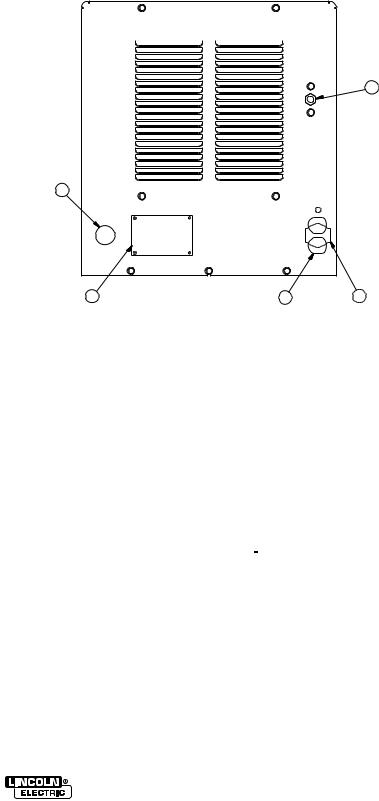
A-4 |
INSTALLATION |
A-4 |
|
|
|
2.Keep the work and electrode leads as short as possible and as close together as possible. Lengths should not exceed 25 ft (7.6m). Tape the leads together when practical.
3.Be sure the torch and work cable rubber coverings are free of cuts and cracks that allow high frequency leakage. Cables with high natural rubber content, such as Lincoln Stable-Arc® better resist high frequency leakage than neoprene and other synthetic rubber insulated cables.
4.Keep the torch in good repair and all connections tight to reduce high frequency leakage.
5.The work piece must be connected to an earth ground close to the work clamp, using one of the following methods:
a)A metal underground water pipe in direct contact with the earth for ten feet or more.
b)A 3/4” (19mm) galvanized pipe or a 5/8” (16mm) solid galvanized iron, steel or copper rod driven at least eight feet into the ground.
The ground should be securely made and the grounding cable should be as short as possible using cable of the same size as the work cable, or larger. Grounding to the building frame electrical conduit or a long pipe system can result in re-radiation, effectively making these members radiating antennas. (This is not recommended).
6.Keep all access panels and covers securely in place.
7.All electrical conductors within 50 ft (15.2m) of the welder should be enclosed in grounded rigid metallic conduit or equivalent shielding. Flexible helicallywrapped metallic conduit is generally not suitable.
8.When the welder is enclosed in a metal building, the metal building should be connected to several good earth driven electrical grounds (as in 5 (b) above) around the periphery of the building.
Failure to observe these recommended installation procedures can cause radio or TV and electronic equipment interference problems and result in unsatisfactory welding performance resulting from lost high frequency power.
SUPPLY CONNECTIONS
Be sure the voltage, phase, and frequency of the input power is as specified on the rating plate, located on the rear of the machine.
See Figure A.1 for the location of the rating plate, the entry hole, and the reconnect panel.
FIGURE A.1
1
2
1.Input Entry
2.Rating Plate
3.115V Receptacle & Breaker
(60 HZ. Machines only)
|
5 |
3 |
4 |
4.220V Receptacle & Breaker (50/60 HZ. Machines Only.)
5.Gas Input Fitting
Remove the right case side to reveal the reconnect panel. Welder supply line entry provision is in the case rear panel. Entry is through a 1.4 inch (36 mm) diameter hole in the case back.1
All connections should be made in accordance with all local codes and national electrical codes. Installation by a qualified electrician is recommended.
1.Connect the terminal marked  (at the base of the welder below the reconnect panel) to an earth ground.
(at the base of the welder below the reconnect panel) to an earth ground.
2.Connect the input leads to terminals marked L1 (U) and L2 (V) on the reconnect panel. Use a single phase line or one phase of a two or three phase line.
1On European, 50/60 Hz. models, entry is through a 1.75 inch (46mm) diameter hole. A reducing washer and plastic strain relief good for 18.0 to 25.4 mm (.709 to 1.00 inch) cords is provided. For larger input conductors a customer supplied plastic strain relief should be used.
SQUARE WAVE TIG 275
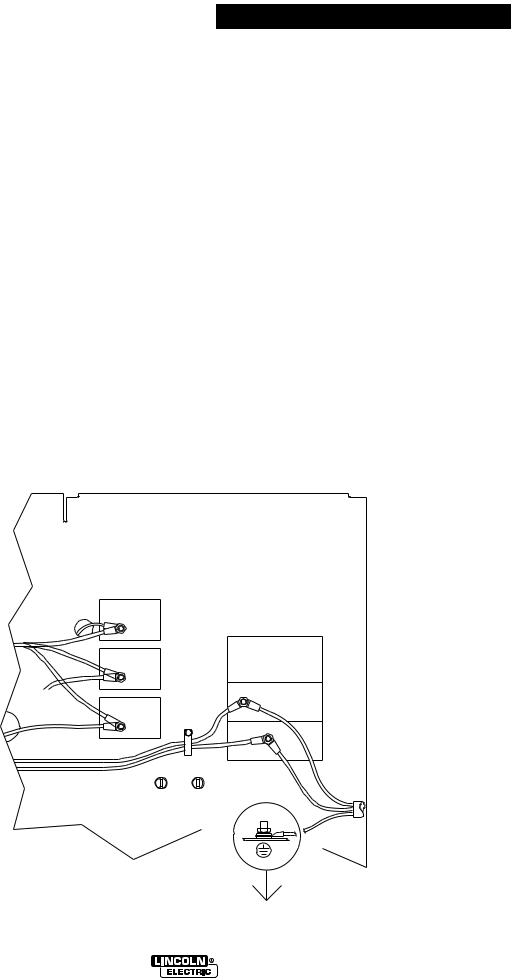
A-5 |
INSTALLATION |
A-5 |
|
|
|
Fuse the input circuit with the recommended super lag fuses or delay type1 circuit breakers. Choose an input and grounding wire size according to local or national codes or refer to the Technical Specifications page at the beginning of this section. Using fuses or circuit breakers smaller than recommended may result in "nuisance" tripping from welder inrush currents even if not welding at high currents.
Unbalanced AC TIG welding draws higher input currents than those for Stick, DC TIG, or Balanced AC TIG welding. The welder is designed for these higher input currents. However, where unbalanced AC TIG welding above 180 amps is planned, the higher input currents require larger input wire sizes and fuses per the
Technical Specifications page at the beginning of this section.
 CAUTION
CAUTION
FAILURE TO FOLLOW THESE INSTRUCTIONS CAN CAUSE IMMEDIATE FAILURE OF COMPONENTS WITHIN THE WELDER.
------------------------------------------------------------------------
Welders are shipped connected for the highest input voltage as listed on the rating plate. To change this connection, refer to the following instructions:
1.Remove the right case side to reveal the reconnect panel.
2.Reconnect the lead marked A to the terminal stud corresponding to the input voltage used. Refer to the figure representing the model being reconnected:
INPUT RECONNECT PROCEDURE
On multiple input voltage welders, be sure the reconnect panel is connected per the following instructions for the voltage being supplied to the welder.
1Also called "inverse time" or "thermal/magnetic" circuit breakers; circuit breakers which have a delay in tripping action that decreases as the magnitude of the current increases.
Figure A.2 |
208/230/460/1/60 Domestic Model |
Figure A.3 |
460/575/1/60 Domestic/Canadian Model |
Figure A.4 |
220/380/415/1/50/60 European Model |
(Con’t) |
|
Figure A.2
Reconnect Panel Instructions for 208/230/460 Domestic Model
SINGLE PHASE INPUT POWER SUPPLY CONNECTION INSTRUCTIONS:
WARNING: Powered by high voltage which can kill. Turn off all input power at the disconnect switch or fuse box before making any connections. Use
input and grounding lead sizes as specified in the operating manual. Failure to follow instructions below can cause immediate failure of components within the welder.
1.Connect the input power leads to the input terminals, L1 (U) and L2 (V), at the right below. Connect the input power leads with the hardware provided. Completely tighten all fasteners.
2.Connect a grounding lead to the ground stud located on the machine base near the input terminals.
3.Welders are shipped connected for the highest rated single phase input voltage with the lead marked "A" connected to the stud marked "4 (HIGH)".
4.For middle range input, reconnect the lead marked "A" to the stud marked "3 (MID)".
5.For low range input, reconnect the lead marked "A" to the stud marked "2 (LOW)".
460V  230V 208V
230V 208V
4 (HIGH) |
|
|
SINGLE |
3 (MID) |
PHASE |
|
INPUT |
2 (LOW) |
L1 (U) |
|
|
|
L2 (V) |
LEADS FOR OPTIONAL
POWER FACTOR CAPACITORS
208/230/460 DOMESTIC MODEL
SQUARE WAVE TIG 275
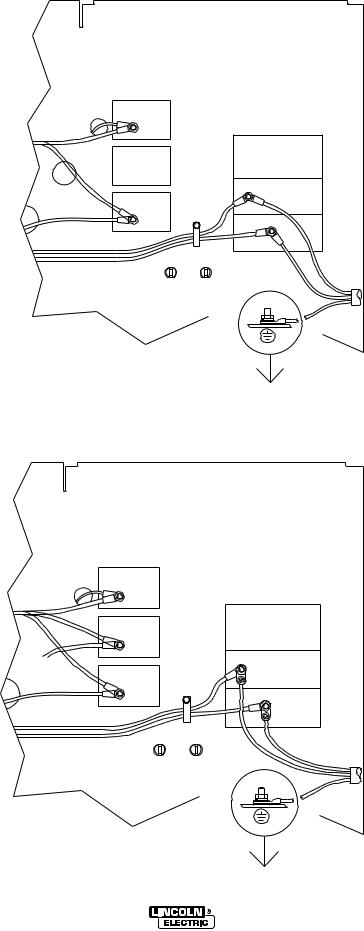
A-6 |
INSTALLATION |
A-6 |
|
|
|
Figure A.3
Reconnect Panel Instructions for 460/575 Canadian Model
SINGLE PHASE INPUT POWER SUPPLY CONNECTION INSTRUCTIONS:
WARNING: Powered by high voltage which can kill. Turn off all input power at the disconnect switch or fuse box before making any connections. Use
input and grounding lead sizes as specified in the operating manual. Failure to follow instructions below can cause immediate failure of components within the welder.
1.Connect the input power leads to the input terminals, L1 (U) and L2 (V), at the right below. Connect the input power leads with the hardware provided. Completely tighten all fasteners.
2.Connect a grounding lead to the ground stud located on the machine base near the input terminals.
3.Welders are shipped connected for the highest rated single phase input voltage with the lead marked "A" connected to the stud marked "4 (HIGH)".
4.For middle range input, reconnect the lead marked "A" to the stud marked "3 (MID)".
5.For low range input, reconnect the lead marked "A" to the stud marked "2 (LOW)".
4 (HIGH) |
|
|
575V |
SINGLE |
|
|
||
3 (MID) |
PHASE |
|
460V |
INPUT |
|
L1 (U) |
||
2 (LOW) |
||
|
||
|
L2 (V) |
|
LEADS FOR OPTIONAL |
|
|
POWER FACTOR CAPACITORS |
|
460/575 CANADIAN MODEL
Figure A.4
Reconnect Panel Instructions for 220/380/415 European Model
SINGLE PHASE INPUT POWER SUPPLY CONNECTION INSTRUCTIONS:
WARNING: Powered by high voltage which can kill. Turn off all input power at the disconnect switch or fuse box before making any connections. Use
input and grounding lead sizes as specified in the operating manual. Failure to follow instructions below can cause immediate failure of components within the welder.
1.Connect the input power leads to the input terminals, L1 (U) and L2 (V), at the right below. Connect the input power leads with the hardware provided. Completely tighten all fasteners.
2.Connect a grounding lead to the ground stud located on the machine base near the input terminals.
3.Welders are shipped connected for the highest rated single phase input voltage with the lead marked "A" connected to the stud marked "4 (HIGH)".
4.For middle range input, reconnect the lead marked "A" to the stud marked "3 (MID)".
5.For low range input, reconnect the lead marked "A" to the stud marked "2 (LOW)".
415V  380V 220V
380V 220V
4 (HIGH) |
|
|
SINGLE |
3 (MID) |
PHASE |
|
INPUT |
2 (LOW) |
L1 (U) |
|
|
|
L2 (V) |
LEADS FOR OPTIONAL
POWER FACTOR CAPACITORS
220/380/415 EUROPEAN MODEL
SQUARE WAVE TIG 275
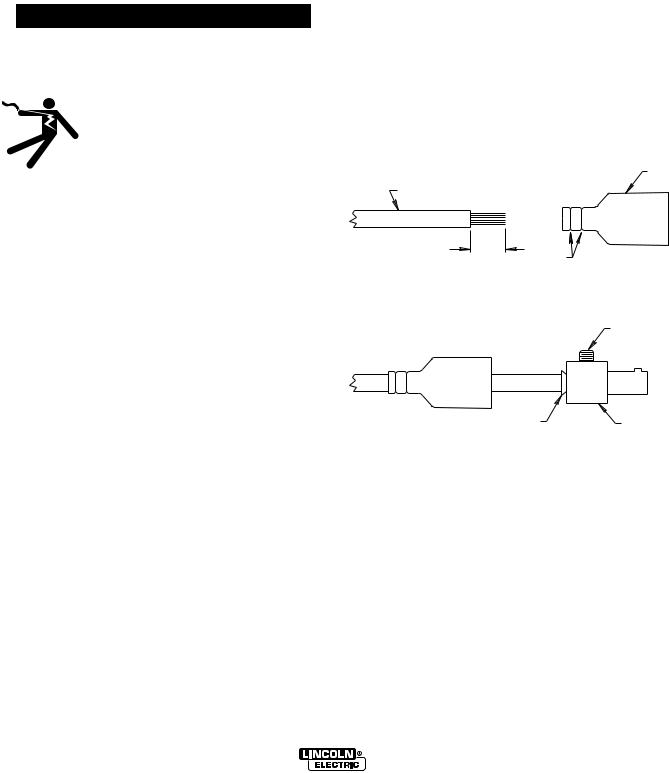
A-7 |
INSTALLATION |
A-7 |
|
|
|
Designations on the reconnect panel LOW, MID, and HIGH correspond to the nameplated input voltages of a triple voltage welder. Dual voltage welders use only LOW and HIGH.
EXAMPLE: On a 208/230/460 volt welder, LOW is 208V, MID is 230V, and HIGH is 460V.
3.Make sure all connections are tight. Replace the case side and all screws.
OUTPUT CONNECTIONS
 WARNING
WARNING
To avoid being startled by a high frequency shock, keep the TIG torch and cables in good condition.
------------------------------------------------------------------------
ELECTRIC SHOCK can kill.
•Turn the power switch of the power source “OFF” before installing adapters on cable or when connecting or disconnecting adapter plugs to power source.
----------------------------------------------------------------------------
See Figure B.1 for the location of the work and electrode terminals, the gas and optional water solenoids, and the Remote Receptacle.The Square Wave TIG 275 is equipped with Twist-Mate connectors for the electrode and work connection.
WORK CABLE CONNECTION
The Twist-Mate connection allows fast and reliable work cable attachment to the work terminal of the Square Wave TIG 275 welding power supply.
Assemble the work cable by attaching the correct Twist-Mate adapter and work clamp to an adequatelysized welding cable. The Twist-Mate cable plug included with the machine is designed to accept a welding cable size of of #2 to #1. See Table A.1 and A.2 for recommended sizes and corresponding hardware.
TABLE A.1
Cable Sizes for Combined Lengths of Copper Electrode and Work Cable
|
Lengths up to |
|
|
|
Machine Size |
100 ft |
100 to 200 ft |
200 to 250 ft |
|
|
|
|
|
|
275 Amp |
#1 (42.4mm2) |
1/0 (53.5mm2) |
2/0 (67.4mm2) |
|
40% Duty Cycle |
|
|||
|
|
|
|
|
TABLE A.2
Recommended Work and Stick Electrode
Components
|
|
|
|
|
|
Twist Mate |
Twist Mate |
Twist Mate |
Work |
Electrode |
|
Cable Plug |
Cable Plug |
Cable Plug |
Clamp |
Holder |
|
for Work |
for Work |
for Work |
|
|
|
Lead |
Lead |
Lead |
|
|
|
(#2 to #1) |
(1/0 to 2/0) |
(2/0 to 3/0) |
|
|
|
|
|
|
|
|
|
K852-50 |
K852-70 |
K852-95 |
K910-1 |
K909-4 |
|
|
|
|
|
|
|
|
|
|
|
|
|
Assemble the correct Twist-Mate-adapter plug to the work cable as follows:
1.Skin the cable jacket to 1.00 in (25.4 mm) for a #2 thru 2/0 (35 thru 70 mm2) cable. Skin the cable jacket to 1.50 in (38.1 mm) for a 2/0 thru 3/0 (70 thru 95 mm2) cable.
2.If necessary, trim the cable end of the rubber boot to match the diameter of the cable.
3.Slide the rubber boot onto the skinned cable end. Use soap for lubricant if required.
BOOT
WELDING CABLE
SEE
ABOVE
TRIM
4.Slide the copper tube into the brass plug. Insert skinned cable into the copper tube.
SET SCREW
(70-95 SIZE MAY HAVE 2 SET SCREWS)
COPPER TUBE |
BRASS PLUG |
|
5.Tighten set screw(s) to collapse copper tube. Screw(s) must apply firm pressure against welding cable.
6.Slide the rubber boot over the brass plug. The rubber boot must be positioned to completely cover all electrical surfaces after the plug is locked into the receptacle. For more details see S18737PRINT or instructions included with the adapter kit.
SQUARE WAVE TIG 275
